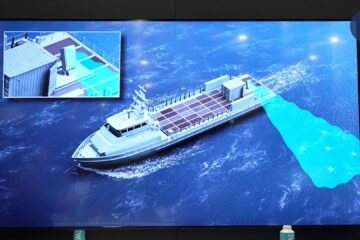By Sgt. Charles Plouffe | 3rd Marine Aircraft Wing
For the first time, Marines, sailors and airmen from across I Marine Expeditionary Force (MEF) embarked more than a dozen fully operational F-35B Lightning IIs aboard the amphibious assault ship USS America.
“We are a force of about 400 based on both ships and ashore – the command element, aviation combat element (ACE) and the ground combat element. We augmented key enablers from I MEF to create a Special Purpose Marine Air-Ground Task Force (MAGTF).”
Lt. Col. John D. Dirk, commanding officer of Marine Fighter Attack Squadron (VMFA) 122, 3rd Marine Aircraft Wing (MAW)

In his planning guidance, the 38th Commandant of the Marine Corps, General David H. Berger, highlighted the value of partnering Marine forces with surface combatants. Particular emphasis was placed on combining Landing Helicopter Assault and Dock (LHA/LHD) ships with superior aviation capabilities unique to the F-35B.
“The ‘Lightning Carrier’ is an LHA/LHD with a jet-heavy ACE embarked. Which means the MAGTF aviation element has more of a strike mindset with 12 or more jets that give the fleet or MAGTF commander the ability to better influence the enemy at range. Tying the sensors and weapons of the F-35B together with those of the fleet is a lethal combination.”
Integrating 3rd MAW’s combat power and capabilities while conducting realistic training is essential to generate readiness and lethality in 3rd MAW units and for naval integration.
“Our relationship with the Navy is important because if we go to war, we won’t be going as just a squadron. We will be going as a joint amphibious force. Being able to deploy 12 or more F-35B’s on a naval vessel is realistic; it’s something that we can’t get every day at Marine Corps Air Stations Yuma, Camp Pendleton or Miramar.”
Maj. Christopher Kelly, executive officer of VMFA-122

Training alongside each other enables the Navy and Marine Corps to improve tactical and technical procedures in terms of mutually supporting one another in the battlespace.
Employing 12 or more F-35B’s aboard an LHA aligns with the Commandant’s Planning Guidance. Partnership with an LHA is the right and relevant warfighting capability for many of the challenges confronting the joint force and provides substantial joint operational flexibility, lethality and survivability.
“The ‘Lightning Carrier’ concept is what we are exercising during this at-sea training,” said Dirk. “I think we will continue to see the Marine Corps exercise these capabilities in the future.” 3rd MAW paved the way for the first F-35B squadron in 2012 and will stand up the first F-35C squadron specifically designed for traditional aircraft carriers in 2020.






